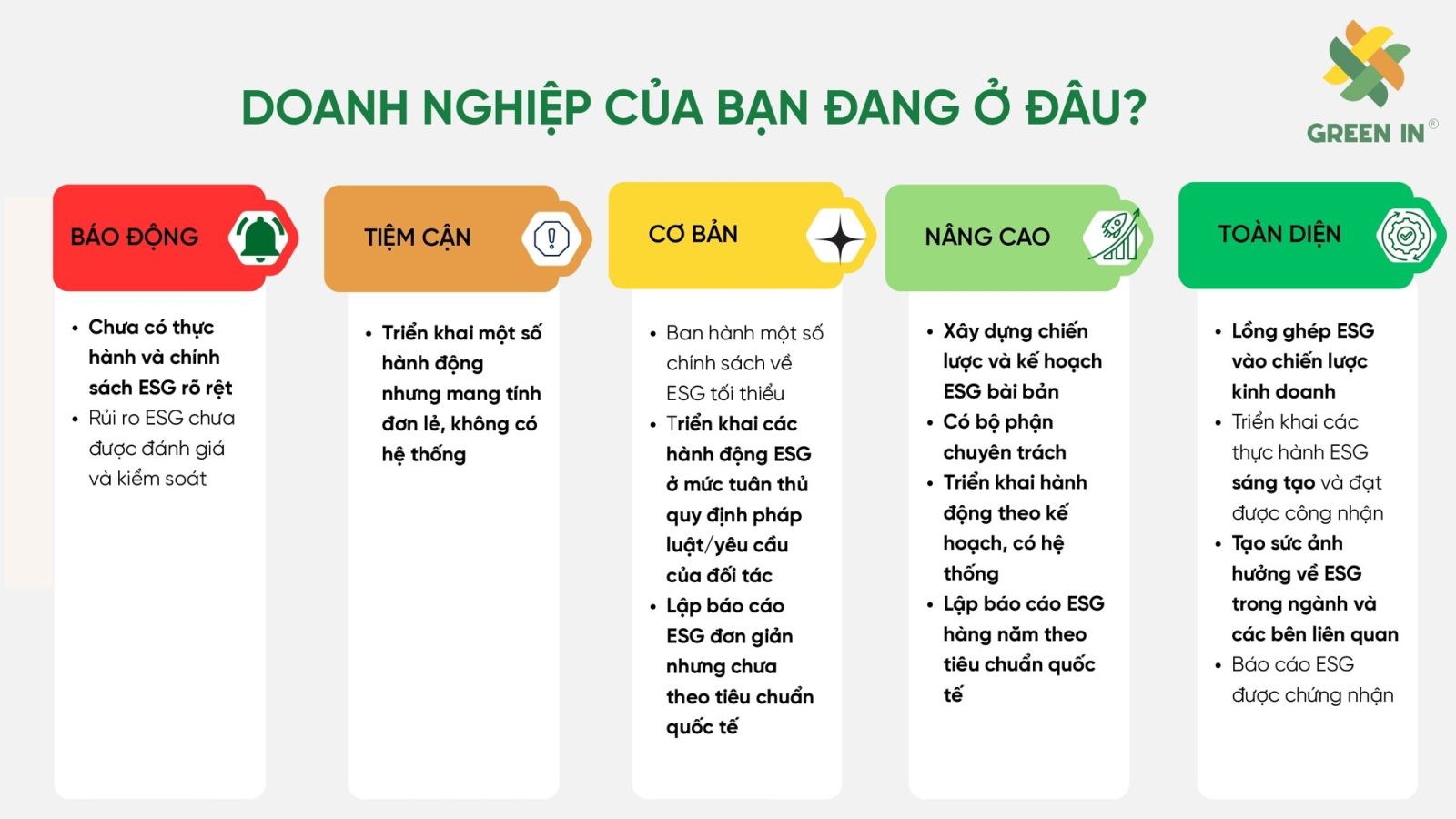
Share:
In today’s global context, ESG (Environmental – Social – Governance) is becoming a “new passport” for businesses. It is not only a factor that international investors and partners consider when cooperating, but also a competitive standard within global supply chains.
In today’s global context, ESG (Environmental – Social – Governance) is becoming a “new passport” for businesses. It is not only a factor that international investors and partners consider when cooperating, but also a competitive standard within global supply chains.
However, in reality, many Vietnamese enterprises remain cautious when approaching ESG. The most common reasons are concerns about implementation costs and the lack of a clear roadmap to move from declaration to actual practice.

???? ESG Roadmap: Beyond fragmented activities

At the conference “Practicing ESG: Strengthening the Competitive Advantage for Vietnamese Manufacturing Enterprises in the Global Supply Chain”, Ms. Nguy Thi Khanh – Strategy Director of Green IN Vietnam emphasized:
-
ESG cannot be reduced to fragmented activities; it requires a long-term vision of 5–10 years.
-
With clear objectives, enterprises can allocate investments in stages, monitor progress, and evaluate effectiveness over time instead of pouring large sums into the initial phase.
-
International standards such as GRI, ISO, or frameworks tailored for SMEs serve as “objective benchmarks” to determine investment levels, prioritize actions, and track progress.
She also highlighted that the choice of standard must align with market orientation and business partners. For example, enterprises exporting to Europe or joining global supply chains will face different requirements compared to those operating solely in the domestic market. In other words, ESG is a tool for strategy, not the ultimate goal.
???? ESG – From Option to Mandatory Requirement
From a macro perspective, Mr. Bui Thanh Minh – Deputy Director of the Office of Committee IV stated that ESG has gone beyond being just a “trend” and is gradually becoming a mandatory requirement.
In a world shaped by geopolitical tensions and trade disputes, major economies are tightening ESG standards and issuing their own regulations. This creates a “compliance maze” that enterprises must navigate to survive and thrive in international markets.
For Vietnam, the national commitment to achieve net-zero emissions by 2050, alongside a plan to significantly cut greenhouse gas emissions by 2030, represents both pressure and opportunity. These commitments are not only national responsibilities but also open up space for businesses to:
-
Transform production models toward greener operations.
-
Adopt green technologies to improve efficiency.
-
Seek energy-saving solutions to optimize long-term costs.
???? Challenge or Strategic Leverage?
From multiple perspectives, ESG is both a challenge and a strategic lever. Early adopters will gain competitive advantages, build stronger trust with international partners, and expand opportunities to participate in global supply chains.
???? Clearly, instead of being hesitant about costs, Vietnamese enterprises should view ESG as a long-term investment, where sustainability generates greater value and enduring benefits for the future.
Latest news
Special Highlights of COP30: When the World Looks to the Amazon for Climate Action of the Future
COP30 marks the 30th Conference of the Parties to the UNFCCC (United Nations Framework Convention on Climate Change).
Criticality Assessment: The First Step Toward Building Resilience
Europe is entering a major transformation in resilience thinking. Under the Critical Entities Resilience (CER) Directive, organizations are not only required to manage risks but also to understand, demonstrate, and maintain the elements that are “critical” to their operations, economy, and society.
Carbon Trading Systems and the Reshaping of the Construction Industry’s Future
The construction industry is one of the largest sources of greenhouse gas emissions, accounting for around 37% of total global CO₂ emissions (IEA, 2022). The expansion of Emissions Trading Systems (ETS) beyond the energy sector into carbon-intensive industries — including building materials and operational processes — is reshaping the entire cost structure and competitive strategies of the construction sector.
Green Finance in Real Estate: Investment Opportunities and Strategies for Developers in Emerging Markets
The global real estate sector is both the largest source of emissions and the greatest investment opportunity in the journey toward net-zero. According to IFC (2025), greening the construction value chain could unlock USD 1.5 trillion in investment opportunities across emerging markets in the next decade.
LCA and EPD: Scientific Evidence for Transparency in Green Certifications
In today’s global context of increasing focus on sustainability, transparency in data has become a critical requirement in the construction industry. Two prominent tools that address this need are LCA (Life Cycle Assessment) and EPD (Environmental Product Declaration). Beyond helping projects earn credits in green building certification systems such as LEED or BREEAM, LCA and EPD are also long-term strategies to enhance credibility and value for projects.
ARDOR Green is recruiting the next generation of sustainable architects/engineers at the Bach Khoa Career Fair
Founded in 2005, ARDOR Architects has over 20 years of experience in architectural and urban planning consultancy, with participation in more than 150 projects and numerous international awards such as Top 10 Architects Ashui (2017) and BCI Asia Awards (2009, 2015, 2021).
Build Green, Build with ARDOR Green







